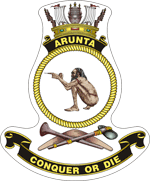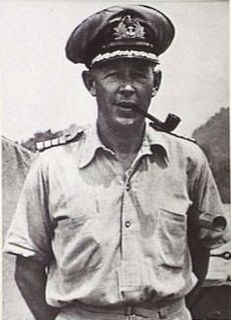Related Research Articles

HMAS Burnie (J198/B238/A112), named for the port city of Burnie, Tasmania, was one of 60 Bathurst-class corvettes constructed during World War II and one of 20 built for the Admiralty but manned by personnel of and commissioned into the Royal Australian Navy (RAN).

HMAS Cootamundra (J316/M186), named for the town of Cootamundra, New South Wales, was one of 60 Bathurst-class corvettes constructed during World War II, and one of 36 initially manned and commissioned solely by the Royal Australian Navy (RAN).

HMAS Maryborough (J195/B248/A122), named for the city of Maryborough, Queensland, was one of 60 Bathurst-class corvettes constructed during World War II, and one of 20 built on Admiralty order but manned by personnel of and commissioned into the Royal Australian Navy (RAN). She was the first naval vessel built in Queensland for the Royal Australian Navy during World War II.

HMAS Swan (U74/F74/A427), named for the Swan River, was a Grimsby-class sloop of the Royal Australian Navy (RAN) that served during World War II.

Air Vice Marshal Conway Walter Heath Pulford, was a senior Royal Air Force officer during World War II. Pulford commanded British forces in the Japanese invasion of Malaya and the subsequent fall of Singapore.

HMAS Arunta (I30/D5/D130) was a Tribal-class destroyer of the Royal Australian Navy (RAN). Named for the Arrernte Aboriginal peoples, the destroyer was laid down in 1939 and commissioned into the RAN in 1942.

HMS Cornwall, pennant number 56, was a County-class heavy cruiser of the Kent sub-class built for the Royal Navy in the mid-1920s. The ship spent most of her pre-World War II career assigned to the China Station. Shortly after the war began in August 1939, she was assigned to search for German commerce raiders in the Indian Ocean. Cornwall was transferred to the South Atlantic in late 1939 where she escorted convoys before returning to the Indian Ocean in 1941. She then sank the German auxiliary cruiser Pinguin in May. After the start of the Pacific War in December 1941, she began escorting convoys until she was transferred to the Eastern Fleet in March 1942. The ship was sunk on 5 April by dive bombers from three Japanese aircraft carriers during the Indian Ocean Raid.

The first HMAS Bendigo (J187/B237/A111) was a Bathurst-class minesweeper, a group commonly known as corvettes and including escort and patrol duties along with minesweeping.

HMAS Westralia (F95/C61) was an auxiliary cruiser of the Royal Australian Navy (RAN). Built by Scottish shipbuilder Harland and Wolff and completed in 1929, Westralia was operated by the Huddart Parker company until 1939, when she was requisitioned for service with the RAN as an Armed Merchant Cruiser (AMC). Fitted with guns and commissioned in early 1940, Westralia was initially used to escort convoys in the Pacific and Indian oceans. In November 1940, the largest mutiny in RAN history occurred aboard the ship, with 104 men charged.

HMAS Bathurst (J158), named for the city of Bathurst, New South Wales, was the lead ship of 60 Bathurst-class corvettes constructed during World War II and one of 20 built for the Admiralty but manned by personnel of and commissioned into the Royal Australian Navy (RAN). Constructed during 1940, the ship spent most of her early career operating with the British Eastern Fleet in the Indian Ocean. She returned to Australian waters in late 1944, then was deployed to New Guinea in 1945, but saw little action. Bathurst was paid off in 1946, and sold to a Sydney scrap merchant in 1948.

Australia in the War of 1939–1945 is a 22-volume official history series covering Australian involvement in the Second World War. The series was published by the Australian War Memorial between 1952 and 1977, most of the volumes being edited by Gavin Long, who also wrote three volumes and the summary volume The Six Year War.

The history of the Royal Australian Navy traces the development of the Royal Australian Navy (RAN) from the colonisation of Australia by the British in 1788. Until 1859, vessels of the Royal Navy made frequent trips to the new colonies. In 1859, the Australia Squadron was formed as a separate squadron and remained in Australia until 1913. Until Federation, five of the six Australian colonies operated their own colonial naval force, which formed on 1 March 1901 the Australian Navy's (AN) Commonwealth Naval Force which received Royal patronage in July 1911 and was from that time referred to as Royal Australian Navy (RAN). On 4 October 1913 the new replacement fleet for the foundation fleet of 1901 steamed through Sydney Heads for the first time.

HMAS Warrego (L73/U73), named for the Warrego River, was a Grimsby-class sloop of the Royal Australian Navy (RAN).

Vice Admiral Sir Roy Russell Dowling, was a senior commander in the Royal Australian Navy (RAN). He served as Chief of Naval Staff (CNS), the RAN's highest-ranking position, from 1955 until 1959, and as Chairman of the Chiefs of Staff Committee (COSC), forerunner of the role of Australia's Chief of the Defence Force, from 1959 until 1961.

Vice Admiral Sir Henry Mackay Burrell, was a senior commander in the Royal Australian Navy (RAN). He served as Chief of the Naval Staff (CNS) from 1959 to 1962. Born in the Blue Mountains, Burrell entered the Royal Australian Naval College in 1918 as a 13-year-old cadet. His first posting at sea was aboard the cruiser HMAS Sydney. During the 1920s and 1930s, Burrell served for several years on exchange with the Royal Navy, specialising as a navigator. During World War II, he filled a key liaison post with the US Navy, and later saw action as commander of the destroyer HMAS Norman, earning a mention in despatches.
The ANZAC Squadron, also called the Allied Naval Squadron, was an Allied naval warship task force which was tasked with defending northeast Australia and surrounding area in early 1942 during the Pacific Campaign of World War II. The squadron, consisting of cruisers and destroyers from the navies of Australia, New Zealand, and the United States was formed on February 12, 1942, under the command of Royal Navy Rear Admiral John Gregory Crace. The squadron was the primary fleet element operating in the ANZAC Area under the overall command of United States Navy Vice Admiral Herbert Fairfax Leary.

HMAS Heros was a tugboat which was operated by the Royal Navy (RN), Royal Australian Navy (RAN) and the Australian shipping firm J. Fenwick and Co. She was built for the RN in 1919, was sold to J. Fenwick and Co. in 1925 and was commissioned into the RAN between 1941 and 1942 and 1943 and 1947 before being scrapped in 1966.

HMAS Goorangai was a 223-ton auxiliary minesweeper of the Royal Australian Navy (RAN). She was built in 1919 for the Government of New South Wales, then sold in 1926 to the fishing company Cam & Sons. The trawler was requisitioned for military service following the outbreak of World War II, converted into a minesweeper, and assigned to Melbourne. She was sunk in an accidental collision with MV Duntroon in 1940, becoming the RAN's first loss of World War II, and the first RAN surface ship to be lost in wartime.
HMAS St Giles (FY86) was a tugboat which was operated by the Royal Navy (RN), Royal Australian Navy (RAN) and the Australian shipping firms J. & A. Brown and the Waratah Tug and Salvage Company. She was built by Ferguson Shipbuilders, Glasgow for the RN in 1919, was sold to J. & A. Brown in 1925, transferred to the Waratah Tug and Salvage Co Pty Ltd in 1931 and was commissioned into the RAN between 1940 and 1942 and 1945 and 1946 before being scrapped in 1956.
Operation Sabre was a Royal Navy military operation in World War II. It involved cutting the Japanese submarine communications cable linking Saigon and Singapore. operating from an X-Craft midget submarine in the Saigon River delta on 31 July 1945.
References
- Gill, G. Hermon (1957). Royal Australian Navy, 1939–1942. Australia in the War of 1939–1945, Series 2: Navy. I. Canberra: Australian War Memorial. OCLC 250134639.
- Gill, G. Hermon (1968). Royal Australian Navy, 1942–1945. Australia in the War of 1939–1945, Series 2: Navy. II. Canberra: Australian War Memorial. OCLC 65475.
- Jose, Arthur (1941). The Royal Australian Navy, 1914–1918. Official History of Australia in the War of 1914–1918. IX (9th ed.). Canberra: Australian War Memorial. OCLC 271462423.